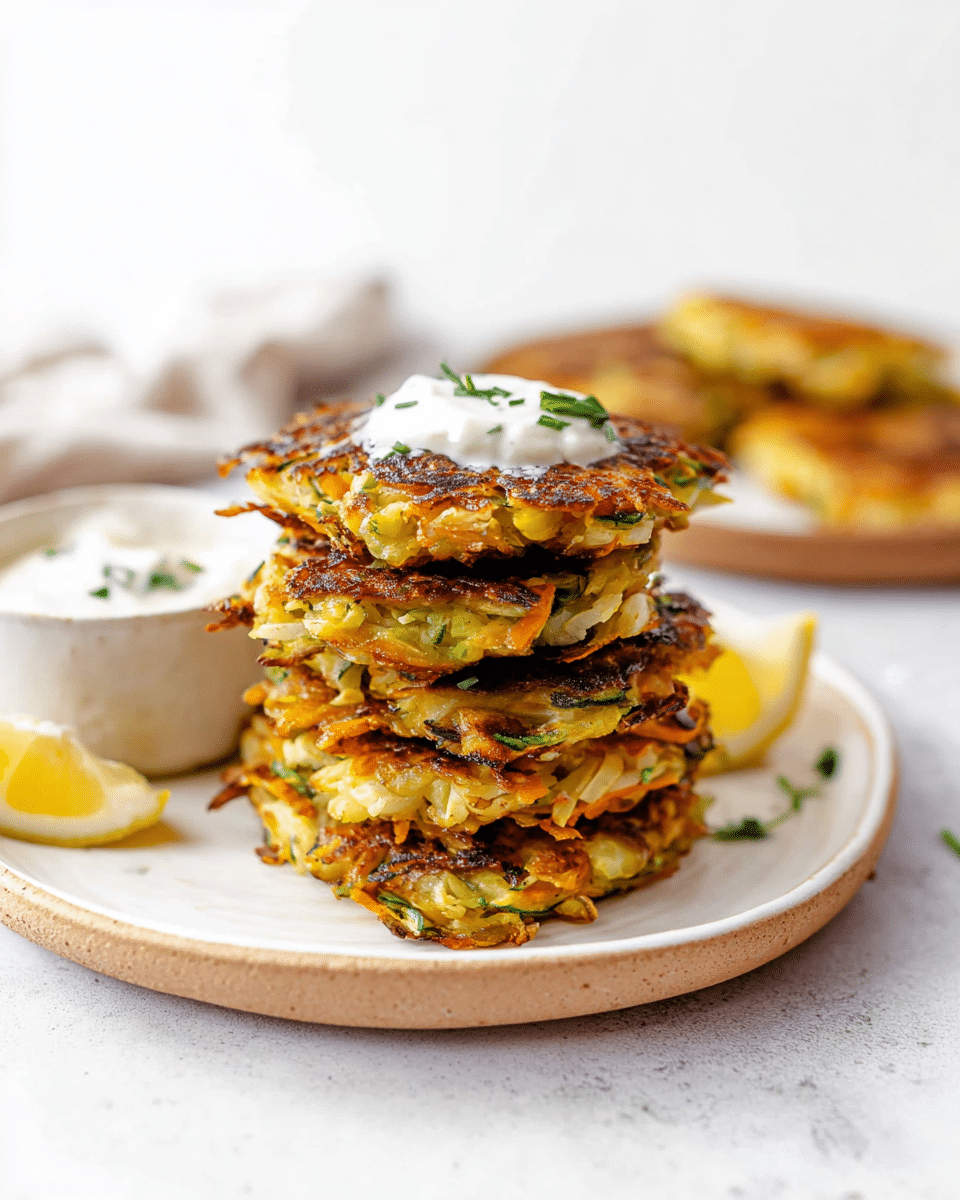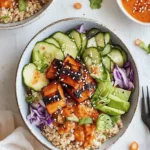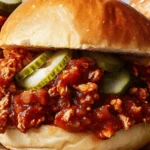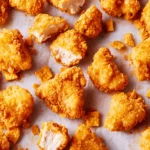These kohlrabi fritters are a delicious way to sneak extra veggies into your meals. Lightly crisped on the outside and tender on the inside, they’re perfect for dipping, snacking, or serving as a fun side dish. Great for both kids and adults!
FULL RECIPE
Ingredients
- 2 medium kohlrabi, peeled and grated
- 1 small carrot, peeled and grated (optional for color and sweetness)
- 2 green onions, finely chopped
- 1 clove garlic, minced
- 2 large eggs
- 1/3 cup all-purpose flour
- 1/4 teaspoon baking powder
- 1/2 teaspoon salt
- 1/4 teaspoon ground black pepper
- Olive oil or neutral oil, for frying
Directions
- Place the grated kohlrabi (and carrot, if using) in a clean kitchen towel and squeeze out as much liquid as possible.
- Transfer the vegetables to a mixing bowl. Add the green onions and garlic, then mix well.
- In a separate bowl, whisk together the eggs, flour, baking powder, salt, and pepper until smooth.
- Combine the wet and dry ingredients with the vegetables and stir until evenly coated.
- Heat a thin layer of oil in a large skillet over medium heat.
- Drop heaping tablespoons of the mixture into the pan, flattening slightly with a spatula.
- Cook 2–3 minutes per side, or until golden brown and cooked through.
- Transfer to a paper towel-lined plate to drain excess oil.
- Serve warm with sour cream, yogurt dip, or applesauce.
Nutrition Facts
- Calories: 145
- Total Fat: 9g
- Saturated Fat: 1.5g
- Cholesterol: 94mg
- Sodium: 310mg
- Total Carbohydrates: 11g
- Dietary Fiber: 2g
- Sugars: 2g
- Protein: 5g
What Makes Kohlrabi Fritters Unique?
Kohlrabi fritters stand out because they transform an often overlooked vegetable into a crispy, flavorful treat. Kohlrabi itself has a mild, slightly sweet flavor with a texture similar to broccoli stems or cabbage hearts, making it perfect for fritters. When grated and combined with simple binding ingredients, it creates a batter that crisps beautifully when pan-fried, delivering a satisfying crunch on the outside and tender, moist vegetable inside. This unique texture and flavor combination make kohlrabi fritters a delightful alternative to more common potato or zucchini fritters.
Nutritional Benefits of Kohlrabi
Kohlrabi is a nutritional powerhouse, offering a low-calorie vegetable rich in vitamins and minerals. It is high in vitamin C, which supports the immune system and promotes skin health. Additionally, it contains dietary fiber that aids digestion and helps maintain healthy blood sugar levels. The vegetable also provides potassium, which is essential for heart health and muscle function. Incorporating kohlrabi fritters into your diet is an excellent way to enjoy these benefits in a delicious, approachable form.
Kid-Friendly Appeal
One of the great things about kohlrabi fritters is their kid-friendly nature. The crispy texture and mild flavor are often more appealing to children than steamed or raw vegetables. The bite-sized fritters are easy to eat and can be paired with familiar dips like ketchup, yogurt, or applesauce to encourage even picky eaters to try and enjoy more veggies. Additionally, the colorful addition of carrots or green onions can make the dish visually inviting for young diners.
Variations and Flavor Twists
Kohlrabi fritters are highly versatile and lend themselves well to numerous variations. You can experiment by adding herbs such as dill, parsley, or cilantro for a fresh twist. For a spicy kick, consider adding chili flakes or a bit of cayenne pepper. Cheese lovers might enjoy incorporating grated parmesan or cheddar into the batter for extra richness. For a gluten-free version, substitute the flour with almond flour or a gluten-free blend. These variations allow you to customize the fritters to your taste preferences or dietary needs.
Serving Suggestions
Kohlrabi fritters can be served in a variety of ways depending on the occasion. As an appetizer or snack, serve them warm with dips like sour cream, tzatziki, or a tangy yogurt-based sauce. For a light lunch or dinner, pair the fritters with a crisp green salad or a side of roasted vegetables. They also work well as a sandwich filling or burger topping to add a crunchy vegetable layer. Their adaptability makes them a great addition to many meal formats.
Pairing with Drinks
When considering beverage pairings, kohlrabi fritters go well with light, refreshing drinks that complement their mild flavor and crisp texture. Sparkling water with a splash of citrus, light white wines such as Sauvignon Blanc or Pinot Grigio, or even a crisp lager beer can balance the fritters’ richness and provide a pleasant contrast. For non-alcoholic options, herbal iced teas or fresh lemonade can brighten the overall eating experience.
Storage and Reheating Tips
To maintain the fritters’ crispiness, store them properly in an airtight container in the refrigerator for up to 2 days. Avoid stacking them to prevent sogginess. When ready to eat, reheat them in a dry skillet over medium heat rather than the microwave to restore their crisp texture. Alternatively, a toaster oven or conventional oven can be used at moderate heat until warmed through. Avoid covering them during reheating, as trapped steam can soften the fritters.
Gluten-Free and Vegan Adaptations
For those with dietary restrictions, kohlrabi fritters can easily be adapted. To make them gluten-free, substitute regular flour with gluten-free flours like rice flour, chickpea flour, or a store-bought blend. For a vegan version, replace the eggs with flax or chia seed “eggs” (1 tablespoon ground seed mixed with 3 tablespoons water, allowed to gel) which help bind the ingredients. Using plant-based milk or additional moisture like mashed potatoes can also help achieve the right consistency without compromising taste.
Cultural and Culinary Context
Fritters are a beloved dish worldwide, with each culture adding its unique spin. Kohlrabi fritters tap into this rich culinary tradition by using a lesser-known vegetable popular in European and Asian cuisines. Kohlrabi itself is often enjoyed raw, roasted, or steamed, but transforming it into fritters highlights its versatility and invites experimentation. This recipe bridges traditional vegetable preparations with modern, family-friendly cooking trends, making it a fresh addition to global home cooking repertoires.
Health Considerations
While kohlrabi fritters are generally a healthy dish, their preparation method—pan frying—can add calories and fat. Using a moderate amount of healthy oils like olive or avocado oil helps keep the fat quality better. For those monitoring calorie intake, baking the fritters instead of frying can be a healthier alternative, though the texture may differ slightly. Overall, the fritters offer a balanced combination of fiber, protein, and vitamins, especially when paired with fresh vegetables or dips like yogurt.
Tips for Perfect Fritters Every Time
Achieving perfectly crispy and golden kohlrabi fritters requires some simple techniques. First, squeezing out excess moisture from the grated vegetables is essential to avoid soggy fritters. Using a hot pan and enough oil ensures even cooking and crispiness without sticking. Don’t overcrowd the pan, which can lower the temperature and lead to steaming rather than frying. Finally, flipping carefully and cooking each side thoroughly will give you that ideal crunchy exterior and tender interior.
Conclusion
Kohlrabi fritters are a versatile, nutritious, and delicious way to enjoy a lesser-used vegetable. Their crispy texture and mild flavor appeal to all ages, especially kids, making them a great addition to family meals. With numerous variations and easy adaptations for dietary needs, they fit effortlessly into diverse culinary traditions and preferences. Whether served as a snack, side, or light meal, kohlrabi fritters offer a satisfying and healthful option that encourages more vegetable consumption in an enjoyable form.






